 |
| The epitome of a XVII Guard unit for Beneath the Lily Banners |
I thought it might be an idea to explain some of the BLB mechanisms by directly comparing opposing troops types in a gaming context both from a shooting and close combat perspective and adding a little detail on the units involved for those interested in collecting or building a particular formation.
Where better to start than with two iconic formations from the Nine Years War:
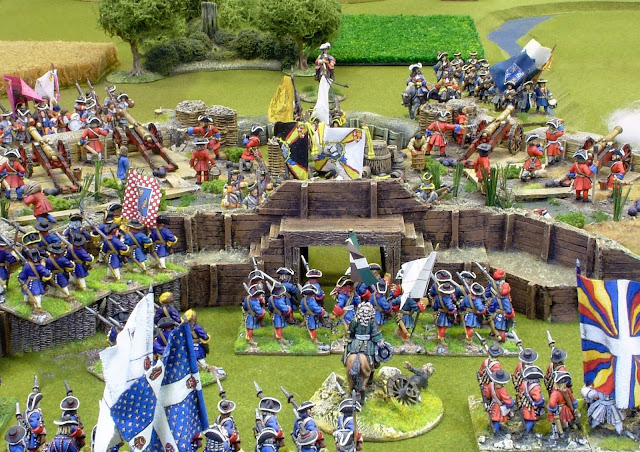 |
| Gardes Francaises and Gardes Suisses in action in a large Malplaquet 1709 scenario |
King Louis XIV's Maison du Roi, in the form of The legendary French Guard or Gardes Francaises and, King Christian V's Danish Household Guard infantry the Garden til Fods.
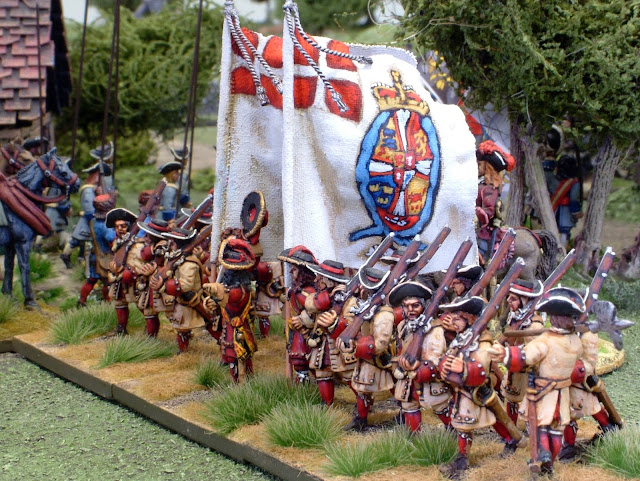 |
| Garden til Fods performing a rearguard action at Neerhespen 1693 |
The French Household troops (Maison du Roi) were a significant body numbering in excess of 6,000 infantry and 2,500 Horse. The regiments were the most prestigious in the army and attracted the Great , the Good as well as the rich as officers.
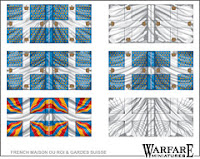 |
| Maison du Roi flagsheet FF010 |
Unlike later centuries, Household troops of the late XVII century were often used as a shock element in battle and had extensive combat experience. King Louis' guard formations had an imposing reputation on the battlefield and were frequently committed for dangerous and critical situations such as defending/taking a breach, smashing the enemy frontline or delivering the coup de grace which they did at Landen/Neerwinden.
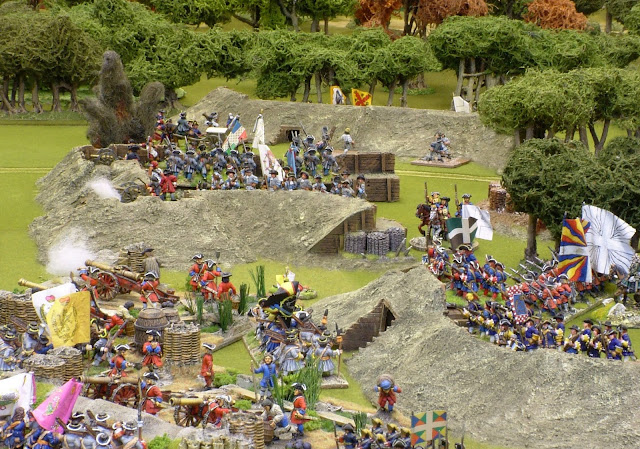 |
| Swiss Guards deep in the defensive position |
There were six battalions of Gardes Francaises (French Guard) and four of Gardes Suisses (Swiss Guards). The regiments were well equipped and officered. The men would have been the pick of the crop. The French Guards wore blue faced red and the Swiss were dressed in reverse colours.
Traditions in the Guard infantry were important and the bodies must be considered reasonably conservative in thinking.
 |
| Both Maison du Roi infantry regiments in action in a LoA Neerwinden scenario 1693 |
When using Beneath the Lily Banners I would always class a single battalion of either regiment as Guard. This is to distinguish them from all other formations on the table as they would by experience and reputation, be at the apex on any comparative scale. If multiple battalions are fielded in a large game I would normally downgrade (ha ha) 4th - 6th battalions to Veteran-Elite or perhaps Drilled-Elite depending on the scenario. This would still retain a very significant edge. Equip them as Regulation although it may be that they are still given matchlock muskets up until quite late in the XVII century.
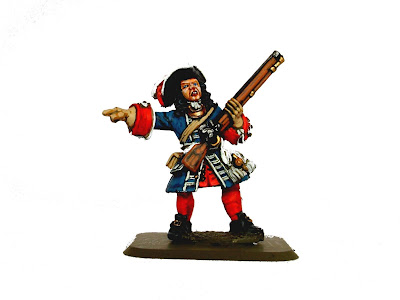 |
| Small conversion job I did on a Front Rank figure for Grades Francaises |
A Regulation Guard battalion equipped with flintlock muskets firing its first volley at close range into an enemy infantry line would throw 7 x d12 looking for 6+ to hit. It also re-throws all misses on that first volley. This is tremendously powerful. In combat a formed, Regulation Guard battalion with a brigadier or personality attached would throw 7 x d12 looking for 5+ to hit. A potentially irresistible force.
 |
| Neerwinden 1693 climax - The cover of BLB 1 Gardes Francaises storm the breastworks |
From a morale perspective a Guard battalion can never get a 1 even on a d12 as +1 is always added to the raw die throw making the lowest base number 2. The special rules for Guards can be found in the Additional Rules section P140 of The War of Three Kings.
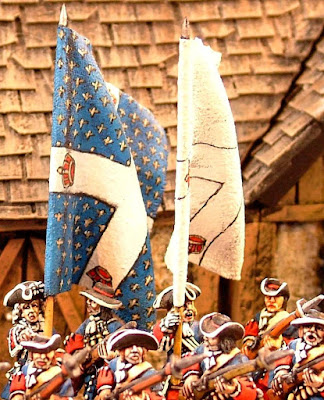 |
| Hand painted on cotton GF flag |
These regiments were present at most of the major battles of the Nine Years War and War of the Spanish Succession (in which period you may field them as All-musket + flintlock) thus increasing firepower but diminishing close combat capability. The Gardes fought at Walcourt, Steenkirke and Neerwinden/Landen.
 |
| Garden til Fods in defence |
So what about the Danes? Danish troops were ubiquitous in Europe during the period 1675-1720 fighting in Sweden, Denmark, Northern Germany, Ireland, Flanders, on the Rhine, Bavaria and Hungary. Their reputation was high. They were generally perceived as capable, disciplined, well turned-out with good field craft and well officered. Many were not Danes with recruits coming from the Baltic states, Poland, Germany and even Scotland.
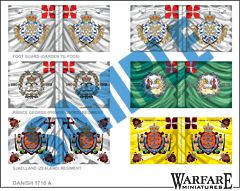 |
| DF01 WSS/GNW Garden til Fods flagsheet |
The Garden til Fods (Foot Guards) was a two battalion regiment dressed in a distinctive straw-yellow coat with dark red facings. It is often portrayed as wearing bright yellow with scarlet facings but this is inaccurate if for no other reason than the lack of dye availability to fix those colours.
The Danes dropped the pike after the end of the Skane War and before the beginning of the Nine Years War. Some battalions may have been equipped with flintlocks quite early. Like Guard units of other monarchs, the Danish Guards were a fighting formation and often found themselves in the van as at Steenkirke or, defending a strategic position.
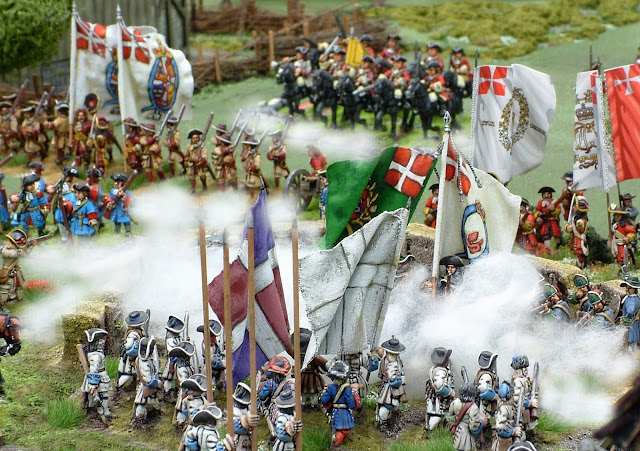 |
| In the thick of it. The Danish Guards attack a French position at Steenkirke |
Players wishing to categorize the Garden til Fods as Guards within the context of Beneath the Lily Banners are of course free to do so but I prefer to give them Veteran-Elite status with a d10 signature die in preference to the d12 of Guard units. As All-Musket the regiment is devastating in a close range first volley situation throwing 8 x d12 if equipped with flintlocks. With a defend order this would rise to 9 x d12.
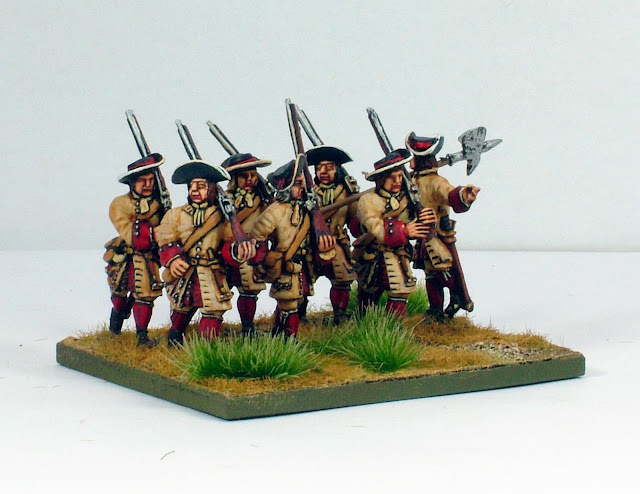 |
| Danish Guards circa 1690 |
In combat they may do less well against Horse (if those were lucky enough to brave the defensive fire) or a Regulation or Pike and Shot battalion but in many years of gaming with or against the Garden til Fods it is rare for the enemy to see their backs in retreat or rout.
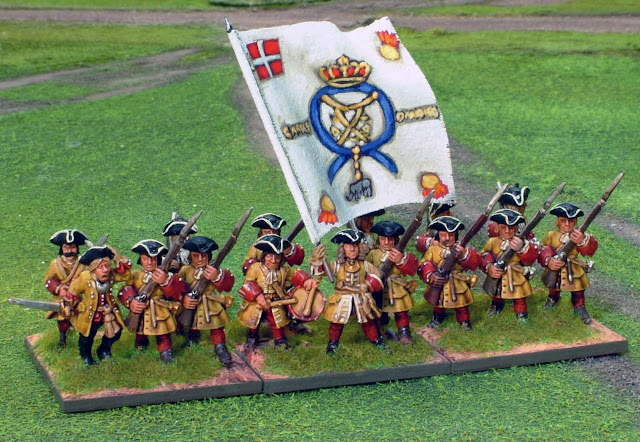 |
| WSS Danish Guards - now living in the USA |
Both battalions rarely served together. The Guards were at the Boyne, Cork, Limerick (twice), Aughrim, Steenkirke, Landen and most of the major battles of the WSS.
When the Danes meet the Maison du Roi on the tabletop, the French may have the edge but the dice are often the leveller. Either would make a fine contribution to your battle plans.
